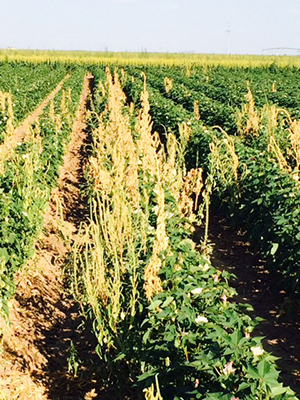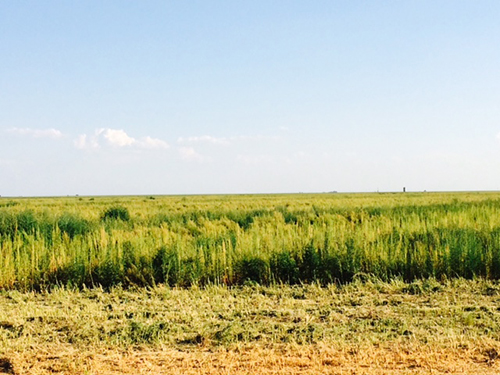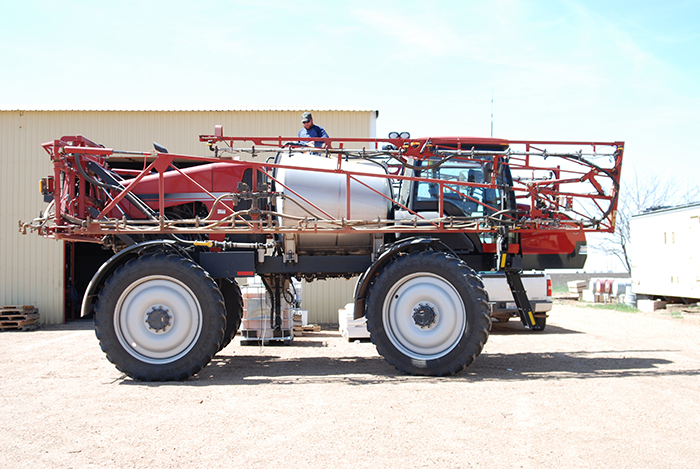Herbicide-resistant weeds are nothing new in the farming landscape, but “bulletproof” Palmer amaranth and kochia are becoming more of a concern because of the long-standing reliance on glyphosate applications.
Brandon Joy likens the situation to no-till farmers being held hostage to their faith in a single mode of action for weed control. The a certified crop advisor for Tri-Star Chemical in Plainview, Texas says the “Roundup-Ready culture” enjoyed good times when glyphosate was among the least-expensive weed control products on the market, at a cost of as little as $8 a gallon a few years ago.
“We lapsed into a reactive mentality since glyphosate offered simplicity,” Joy told growers assembled at a field day recently in Texas. “Instead of treating weeds when we saw them, we got into bad habits. We would just spray when time allowed. We could kill large weeds with glyphosate, so we would put off spraying, take a few days off and clean up a lot of mistakes with late applications when weeds had gotten away in the crop.
“Many producers fudged on the rate of chemical they applied. Now, the ability to kill large weeds with glyphosate has passed us by.”
Planning Crucial
While corn, soybean and cotton growers may not really be facing “super weeds” as yet, plenty feel they’re seeing a growing number of herbicide-resistant weeds choking fields.
Palmer amaranth, waterhemp and kochia are at the forefront of concern. Weed resistance may not be anything new, but there’s not a lot on the horizon in the way of truly new herbicides with different modes of action these days either, experts say.

Brandon Roy
Robert Wilson, a veteran of 40 years as a weed specialist at the University of Nebraska’s Panhandle Research and Extension Center at Scottsbluff before retiring last December, foresees a shift away from reliance on herbicides and toward greater use of cultural practices for weed control. That said, he believes herbicides will continue to play an important role in keeping weeds in check.
“Many growers are set in their ways and don’t want to change how they do things, even though weed control is failing,” he says. “This isn’t a popular notion with no-tillers, but we may have to do things like timely cultivation, or we may even have to plow every 5 or 6 years to bury much of the Palmer pigweed and kochia seed.
“Pigweed and kochia seed aren’t long-lived and if we plow them down deep occasionally they are not going to give as many problems,” says Wilson.
For devout no-tillers, a program including pre-emerge herbicides and layby herbicides has proven effective through the years in controlling late-germinating weeds — something to keep in mind with both Palmer and kochia germinating throughout the growing season.
Wilson agrees that some farmers may have skimped on rates of glyphosate and other herbicides, but adds that in the presence of true glyphosate resistance, adding more glyphosate or an adjuvant to the mix won’t help, and may even accelerate the arrival of resistance.

Looking for ways to deal with pigweed that is resistant to glyphosate, a number of growers on the southern High Plains resorted to an old tool this summer and pulled out their rope wick applicators to knock out pigweed grew up through the crop canopy in cotton fields treated with Paraquat.
A proven concept on no-till has particular application in the presence of herbicide resistant weeds.
“Rotation to different crops, and to different herbicides with good residuals, is important when battling resistant weeds,” Wilson says. “Pre-emerge herbicides or layby herbicides were effective on late-germinating weeds in the past, and we may need to get back to that.
“We at one time used growth regulators in rope wick applicators to good effect. Growth regulators give good action on Palmer amaranth. Maybe we need to revisit that practice.”
Based on his extensive experience, Wilson advises that farmers need to incorporate more non-Roundup Ready crops in their rotation. Planting crops at different times, so that varied weed-control options are available, gives farmers choices.
“Including small grains such as winter wheat in the rotation can make a major difference in weed-control possibilities, and residue from the wheat crop can also prove an important tool in mulching and shading out weed seedlings,” Wilson says. “Starane plus 2,4-D used with the wheat crop has excellent activity on kochia. Herbicides coupled with crop rotations break the cycle of resistant weed emergence.”
Dealing with herbicide resistance requires farmers to become forward thinkers, he adds.
“You have to look at the whole rotation — two, three or four crops down the road across the whole farm — and how to control weeds over the long run of several years with every weed, every crop,” Wilson says. “Thinking and planning in that way can pay real benefits over the long run.”
What to Do
Preventing or managing resistant weeds requires producers to plan for success, rather than only considering the possibility of a crop failure in late winter or early spring. Joy emphasizes staying pro-active and combating weeds in fields before they are even there.
“Producers today must start the year with clean fields and keep them clean with an integrated weed management approach” he says.
Measures in such a system include rotation of both crops and herbicide modes of action, along with the use of full rates of herbicides and tank-mix partners from different groups of herbicides.
“We need to control weedy escapes, including good sanitation and cleaning of equipment from field to field,” Joy says. “Growers must take time to clean sweeps between fields — they can drag weed problems from one field to another. The hoe has a place. Growers have to get those escape weeds, even if it means you need to use a hoe before the weeds go to seed.”
He discourages abandoning yellow herbicides, even though they may limit rotation options in a failed crop situation.

Fields occasionally get away from growers despite efforts to control weeds, but shredding, followed by one or two herbicide applications, can bring the weed riot under control.
Mix it Right
While he’s in the chemical sales business, Joy says many producers essentially “pour thousands of dollars out onto the ground” with ineffective weed control when mistakes are made in loading tank mixes of chemicals.
“The order of mixing matters. Producers should fill the tank ½ to ¾ full, then put in dry products, followed by flowable liquids, emulsifiable concentrates and water-soluble liquids,” he says. “The tank should be topped off last, and agitation should be maintained. You have to fill in the correct order and pay attention to the mixing order.”
There are many other reasons for herbicide failure, in addition to tolerance or resistance shown by some weed species. Joy says such issues are almost never a product integrity problem.
Improper mixing of herbicides or mistakes in calibrating the sprayer can be issues, as are improper, or lack of, appropriate adjuvants. An example is the importance of ammonium sulfate and methylated seed oil to the herbicide Sharpen.
“Weed control is chemistry and there is variability. Big weeds are hard to kill,” Joy says. “ Herbicide effectiveness can be an issue. If there are 10 weeds per square foot in a field and you get 90% control with herbicide, that still leaves 1 weed per square foot, and that’s a failure.”
Joy advises producers who may doubt the effectiveness of a herbicide to skip a spot in the field to prove to themselves whether or not the herbicide works.

When using tankmixes of herbicides, adding them to the mix in the correct order can be crucial to the success of weed control, says Brandon Joy, a certified crop advisor from Plainview, Texas. With Palmer amaranth and kochia showing herbicide resistance, using herbicides with different modes of action is especially critical.
Don’t Be Late
Timing of herbicide applications is a season-long issue that should include fall, late winter, early spring and in-season applications.
Joy says most the time he advises growers to spray behind the planter, but they may want to do it sooner if rain is in the near forecast to get residuals out before emergence.
The best way to know what’s happening with weed populations is to scout fields, he says, as it reveals weed presence and size and helps producers arrive at a decision on when to spray. Environmental factors and the calendar can also weigh upon spraying decisions.
Proper herbicide application methods also have a bearing on the success of weed-control efforts.
“Ground speed of the spray rig is important. Most producers have lots of acres to get across and a higher ground speed gets you through the fields faster. But for best control, you should slow ground spray rigs as much as possible,” Joy says.
The number of gallons per acre of water growers use in applying the herbicide is important. Putting out 10-20 gallons of water per acre, depending on the product being used, may be the difference in a hit or a miss in weed control.
“Water doesn’t kill weeds, but good coverage does,” he says. “It’s a temptation to cut back on the water rate when there are lots of acres to get across and more water has to be hauled, but skimping on water may cost you control.”
Important equipment in the battle with weeds includes a broadcast boom and drop nozzles, and hooded sprayers. Rope wick application equipment is also regaining practicality. While it’s a tool of intense labor, the hoe is once again the stopgap measure to take down stubborn escapes.
When weed control becomes challenging, growers are willing to try new ideas and techniques. Many producers have resorted to applying Paraquat through a rope wick applicator when all else failed.
“I had doubts, but the wick application of Paraquat did a good job of controlling weeds above the crop canopy,” Joy says. “Weeds below the canopy were missed, meaning additional passes through the field were necessary when the remaining weeds grew up through the crop canopy.”
Down to Specifics
A recent “From The Desk Of” column by managing editor John Dobberstein shared several tips from Kansas State University weed specialist Dallas Peterson on controlling herbicide-resistant Palmer amaranth in soybeans.
Below, Joy offers general crop-b- crop recommendations for weed control measures in the southern High Plains.
- Cotton: Joy says a season-long program is now necessary for fully effective weed control. In November/December, Paraquat or Aim should be applied to burn down any early winter weeds.
Preplant weed control starts in earnest in February and March, says Joy, with application of glyphosate and Dicamba, 2,4-D and Valor. Prior to planting in April or May, applications can include Paraquat, Caparol/Direx plus Prowl H2O — and Joy says the latter application “has to be done right or you waste your money.”
In May and June, weed treatment can include glyphosate/Liberty plus Dual, Warrant, or Staple.
With the cotton crop aggressively growing in June and July, growers can utilize hooded sprayers in their weed control program.
“Growers fight weed resistance in cotton by incorporating residual herbicides in their weed-control program. That can be a challenge in a no-till setting. Beginning in February, you want to have products overlap through the growing season,” Joy says.
- Corn: In November or December, Paraquat or Aim is the best choice, and in February or March growers should consider glyphosate plus Dicamba and 2,4-D plus Valor. At planting, Sharpen plus Atrazine plus Dual or Outlook is recommended.
For layby applications, Status plus Solstice plus Atrazine, or Status plus glyphosate plus Impact is best, he says.
- Sorghum: In November or December, consider Paraquat or Aim, and in February or March apply glyphosate plus Dicamba plus 2,4-D plus Valor, Joy says. In April or May, use Sharpen plus Atrazine plus Dual/Outlook.
In May, June and July, Huskie plus Atrazine plus Clarity or Starane, or Buctril plus Peak plus Starane can work. Joy says he’s impressed with the later mix option of Buctril/Peak/Starane as it has killed some larger weeds in sorghum.
- Wheat: Joy recommends a pre-plant burndown application of Sharpen, Paraquat or glyphosate. Post options include 2,4-D, Dicamba, Affinity Broadspec, Powerflex HL, Peak, Ally or Ally Extra.
“Be in the field scouting for weeds while they’re small, and be mindful of any potential crop-rotation issues, especially with some of the herbicides used in wheat,” Joy says.
- Fallow: Growers should consider rotation options. In wheat stubble left fallow, Paraquat and Direx are options, as are Paraquat and Valor and possibly Starane.
“Wheat stubble is valuable,” says Joy. “Don’t just take the plow to the field. In the case of volunteer cotton, it can be handled with herbicides, although a couple of applications may be needed rather than just one. “
While another glyphosate “silver bullet” isn’t on the horizon for the foreseeable future, crops tolerant of Dicamba and 2,4-D are upcoming, and Liberty Link — used within its limitations — will work well, Joy says.
During challenging times in weed control, Joy says growers must be pro-active.
“Don’t wait until you see weeds to attempt to control them,” Joy warns. “We may have to revert to the conventional mindset of overlapping residuals, using some old herbicides, and some new ones. Plan for success and rotate herbicides. If you don’t succeed with weed control, you won’t succeed with the crop.”






Post a comment
Report Abusive Comment